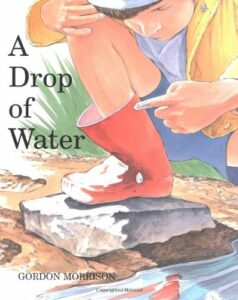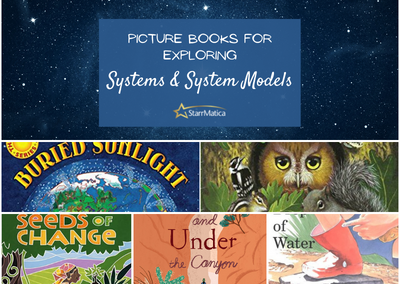Picture books are a great way to get students to examine the crosscutting concepts of the Next Generation Science Standards. New to the crosscutting concepts? Here’s a quick summary! The crosscutting concepts are one of the three dimensions of the NGSS. The seven crosscutting concepts are lenses through which your students can examine different phenomena. Using the CCC helps students to better understand both known and unfamiliar phenomena, so it can be worthwhile to spend some time helping them to dig in and really understand what each concept means. Using picture books can help make the CCC accessible to students of all ages!
The picture books shared below are fantastic for examining the crosscutting concept of Systems and System Models. There are systems all around us. A system can be as small and contained as a single cell or as large as the universe. It can be living like our bodies or non-living like the water cycle. And system models help us to understand systems and predict future outcomes. For example, model of a river system might help us to predict the effects of seasonal flooding on people and property.
Whether you are reading the following picture books aloud, having students explore them in small groups, or having students read them independently, the following questions can be used to help students focus on systems and system models:
- What are the key parts of the system, and how do they work together?
- Where does the system begin, and where does it end?
- What process is occurring? Can you describe it?
- What energy (or matter) flows into, within, and out of the system?
- If you could control X in the system, would it stop Y? Why or why not?

Buried Sunlight: How Fossil Fuels Have Changed the Earth by Molly Bang and Penny Chisholm is an engaging book that explains how oil, coal, and gas are really “buried sunlight,” trapped beneath Earth’s surface for millions and millions of years and how our use of these fuels changes the Earth.
Activity Idea: Pair this text with a STEM lesson from NASA on melting ice and rising sea levels.

Seeds of Change by Jen Cullerton Johnson tells the story of Wangari who blazed a trail as a woman scientist and returned to her native Kenya to effect change by planting trees to combat corporate deforestation.
Questions to Discuss: What environmental issue in your community would you like to solve? What solutions can you brainstorm to solve it?

Over and Under the Canyon by Kate Messner is part of a series of “over and under” books. Each text contains illustrations that convey movement and unique perspectives and text that explores two different worlds within one ecosystem. Students learn about the many animals that call each habitat “home.”
Activity Idea: Check out PBS’s Plumb Landing ecosystem games. Students can explore the Canadian Rockies, Belize Magroves, Borneo Rainforest, and Australian desert to discover, photograph, and learn about plants and animals that call those habitats home.

The Busy Tree by Jennifer Ward examines the habitat of a single tree and the shelter it provides for multiple organisms.
Activity Idea: This would be a great text to compare and contrast with The Great Kapok Tree by Lynne Cherry. How is the message of each text and the relationship of the animals to the tree described in each text similar and different?

A Drop of Water by Gordon Morrison captures a single moment in time is poetically and beautifully in this story about a drop of water on a boy’s fingertip and where the journey of that droplet began, bringing to light both the water cycle and all the life that depends on it and connects one another.
Questions to Discuss: Where did the drop of water in the book come from? Can you trace a drop of water back to its source? Why or why not? What system can you identify in the text? What are the parts of the system? How do they interact?
If you are a StarrMatica Texts: Science Your Way subscriber, you can check out the texts below that align with an exploration of systems and system models. Remember, each 1st – 5th grade text has multiple reading levels so all of your students can read the same content independently.
- Kindergarten: Oh Deer; Why Do I Live Here?
- Second grade: Building Better Beaches; Preventing Erosion; Living in the Cloud Forest; Welcome to the Cloud Forest
- Third grade: Grouping Up; Safety in Numbers; Protecting the Giant Pandas; Saving the Giant Pandas
- Fourth grade: Rainbow Rocks; Curious Clouds and CFCs; A Race Toward Ozone Recovery; Fossil Fuels and Clean Energy; Plants Power Our Future; Powerful Plants; Plant Power
- Fifth grade: Traveling Through the Water Cycle; What Is the Water Cycle; Weather and the World; The Layered Ocean of Life; Cool Composting!; Create A Compost!; Does Farming Help or Harm the Earth?; Why Are Forests Disappearing?; The Creative Cycle of Food; The Weight of a Closed System; The Sun’s Nourishing Energy
Not a subscriber? Click here for a free trial to access the texts above.
 And if you are looking for additional picture books for your science classroom, check out the Perfect Picture Book Pairing Series that includes one-page guides with activities and discussion questions for hundreds of STEM-themed picture books aligned to every NGSS performance expectation!
And if you are looking for additional picture books for your science classroom, check out the Perfect Picture Book Pairing Series that includes one-page guides with activities and discussion questions for hundreds of STEM-themed picture books aligned to every NGSS performance expectation!
CLICK HERE TO PREVIEW THE PERFECT PICTURE BOOK PAIRING EBOOKS
Be sure to check out the other posts in this series to discover picture books to highlight each of the seven crosscutting concepts in the NGSS!

Want to save even more time with lesson ideas for 35 picture books that you can use to highlight all seven crosscutting concepts?
Enter your information below to receive your complimentary picture book guides including activity ideas, science questions, and crosscutting concept questions!


